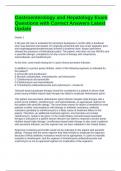Exam (elaborations)
Gastroenterology and Hepatology Exam Questions with Correct Answers Latest Update
- Course
- Institution
Gastro 1 A 38-year-old man is evaluated for persistent dyspepsia 2 months after a duodenal ulcer was detected and treated. He originally presented with new-onset epigastric pain, and esophagogastroduodenoscopy showed a duodenal ulcer; biopsy specimens showed the presence of Helicobacter pylori. ...
[Show more]



